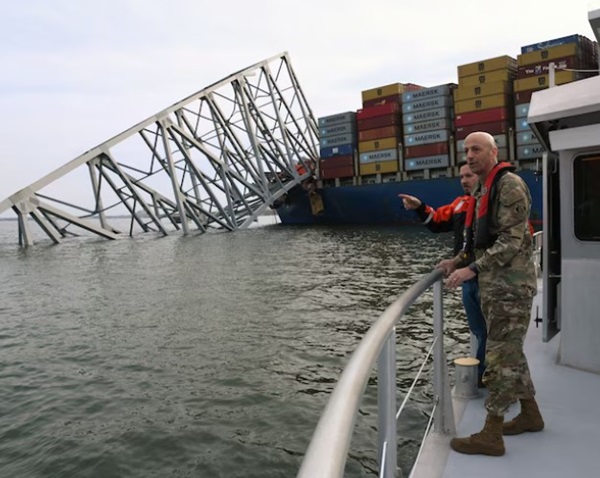BALTIMORE, MD—The U.S. Army Corps of Engineers in Baltimore is working closely with local, state, and federal partners to clear the wreckage left behind by the recent collapse of the Francis Scott Key Bridge.
A release from the USACE said that a 280-foot-wide and 35-foot-deep channel has been created within the Port of Baltimore, which will allow for one-way traffic for barge container services as well as some roll-on/roll-off vessels that transport cars and farm equipment to and from the port.
The USACE is hopeful that the 700-foot-wide by 50-foot-deep federal navigation channel will be restored by the end of May, which will allow for normal service to resume.
“Thanks to the exhaustive work of the Unified Command during the last two weeks, including underwater surveys and detailed structural analysis of the wreckage, we’ve developed a better understanding of the immense and complex work that lies ahead,” said Lt. Gen. Scott A. Spellmon, USACE commanding general. “A fully opened federal channel remains our primary goal, and we will carry out this work with care and precision, with safety as our chief priority.”
It is important to note that these timelines may be subject to change due to significant adverse weather conditions or other complications. The USACE will continue to work with partners to ensure that the port is reopened safely and promptly.
Governor Wes Moore released the following statement on the public release by the U.S. Army Corps of Engineers regarding a timeline for reopening the Fort McHenry Channel:
”As we learned this evening, this ambitious timeline proposed by the Army Corps of Engineers offers a level of clarity and certainty that Baltimore needs to hear so we can collectively plan for continued recovery efforts – related to both our economy and our infrastructure. We and our partners across all levels of government have been pushing for a timeline, and now we have a target. We must do everything we can to meet that target.
As I’ve said many times, this is a complicated operation. For the workers and businesses that rely on the Port, we need to do everything in our power to move as quickly and as safely as we can to clear the channel and fully reopen vessel traffic to the Port of Baltimore. For the families, we must continue to do everything we can to bring them closure.
In the coming days, we will work closely with the Army Corps of Engineers and Unified Command to continue evaluating the assessment so we can ensure we remove any obstacles that might prevent completion. I will deploy every available asset under my control to support this mission. We need to move with utmost speed – and we must execute every operation in a way that advances the four key directives I’ve issued to Unified Command.
This work is complex. But by standing united, working together, and moving in partnership, we will continue to prove the full meaning of Maryland Tough and Baltimore Strong.”
Thank you to @usacehq and all our partners for their tireless efforts. We are grateful to have a tentative timeline that will guide our recovery and response at the local level.
Together, we will get through this. pic.twitter.com/kysmlmf7ca
— County Executive Johnny Olszewski (@BaltCoExec) April 4, 2024
Photo: USACE Chief of Engineers Lt. Gen. Scott Spellmon views damage of the fallen Francis Scott Key Bridge that collapsed in Baltimore, March 26, 2024. In accordance with USACE’s federal authorities, USACE will lead the effort to clear the channel as part of the larger interagency recovery effort to restore operations at the Port of Baltimore. (U.S. Army Corps of Engineers photo by Maj. Spencer Garrison)
This article was written with the assistance of AI and reviewed by a human editor.
Do you value local journalism? Support NottinghamMD.com today.

